Xenophon PCDGS
Veteran Member
Does anyone have any photo images that they took of these shunters on the breakwater?
I note that 002 was scrapped.
What about 001 was that scrapped as well?
Not certain, but I think the story was:One wonders what were the diesels' predecessors, as no BR main line steam loco seems allocated there. If just an industrial steam loco, how did it get moved over to be a BR mainstream operation.
How did the locos, and wagons, get there? Presumably by road.
On these small shunters, the 6-cylinder Gardner engine and the Wilson gearbox were the same as on the Crosville buses of the era at their Holyhead garage, so presumably there was some element of local support available.
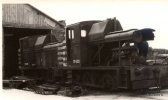
I can't add anything about the 01 shunters, I'm afraid, but I assumed my father would have visited the area if there were steam locomotives in the quarry and sure enough his records indicate that on the day of his visit - 25 Mar 38 - there were two locos seen in the limestone quarry area, known then as WM Wild &Sons Ltd - Silica Works. (makers of Silica bricks apparently) The two were a Andrew Barclay (1584/17), previously from Spillers of Seacombe and a Peckett (1873/34). I have no idea whether either of these locos had anything to do with the Breakwater Railway...unless of course the Peckett was the replacement that @6Gman mentions, having only been built in 1934.Not certain, but I think the story was:
The breakwater was built for the LNWR using stone taken from the quarry (known as Twr Quarry) on Holyhead Mountain, variously quoted as 6-7 million tons. The railway was operated by the quarry company since they were the sole supplier for both construction and maintenance.
It is said that the railway was converted from broad to standard gauge and that the loco (named Prince Albert) was regauged. By the 1930s it was life-expired and was replaced by a (new?) loco, named Crowhurst. The operator of the quarry was the Crowhurst Silica Quarry company hence the loco's name.
I believe the quarry closed in the late 50s/ early 60s (or lost the contract) which meant that the quarry company was no longer involved, and stone had to be brought in by road and then transferred to the rail wagons for movement onto the breakwater. Clearly the quarry company loco was not an option so the diesels were brought in. They were brought in by road.
I know things can be informal at distant locations but I doubt Crosville provided any support. A fitter from Crewe seems more likely!
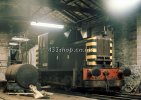
Is it BR blue? It's certainly hard to tell what colour it's supposed to be!Notice that although it is in BR blue colour and with its later number, it wears a "lion and wheel" crest on the cab.
I think that they were both black, tbh
Bear in mind that the stripes will have been a later addition to the locomotives though - and the angle that the photo's taken from may have had an effect too.It is difficult to tell for sure, but to me the black of the wasp stripes looks to be a darker colour than the bodywork
| BR (1955 Number) | BR (Pre Tops) | BR (Tops) | BR (Dept) | Built | Code | Depot Name | From | Date Withdrawn |
| 11504 | D2954 | 01001 | 19/02/1956 | 30A 9D 6J W | Stratford (New) Newton Heath Holyhead Withdrawn | 19/02/1956 01/05/1965 10/06/1967 14/09/1979 | 14/09/1979 | |
| 11505 | D2955 | 01002 | 19/02/1956 | 30A 9D 6J W | Stratford (New) Newton Heath Holyhead Withdrawn | 19/02/1956 01/05/1965 10/06/1967 15/03/1981 | 15/03/1981 |
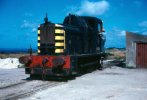
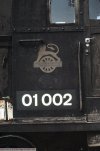
Looks black to me, albeit a rather old and faded black.
View attachment 103987
EDIT:
Found this close-up photo as well showing the new number applied over the old paint:
(from https://www.2d53.co.uk/holyhead/Breakwater.htm )
View attachment 103988
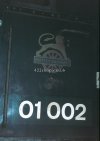
The doors looks to be made of woodLooks black to me, albeit a rather old and faded black.
View attachment 103987
EDIT:
Found this close-up photo as well showing the new number applied over the old paint:
(from https://www.2d53.co.uk/holyhead/Breakwater.htm )
View attachment 103988
Many early diesel shunters had wooden doors, so they may be original (possibly held together by woodworm holding hands, though).The doors looks to be made of wood
The early 08's were also built with wooden doors. As to the livery it was the original BR black and I believe these were the only locos still in Black to recieve TOPS numbersThe doors looks to be made of wood
Presumably a replacement? Not something I would expect to see on a loco built in the 1950s.
Many early diesel shunters had wooden doors, so they may be original (possibly held together by woodworm holding hands, though).
Ah okay, didn't realise there were still new build locos being fitted with wooden doors in the 50s.The early 08's were also built with wooden doors.
A good question, but I suspect there was no good reason to renumber them.Why were they given revenue stock numbers?
It would have seemed more appropriate to have put them into one of the engineering number sequences e.g: ED / DS / PWM
